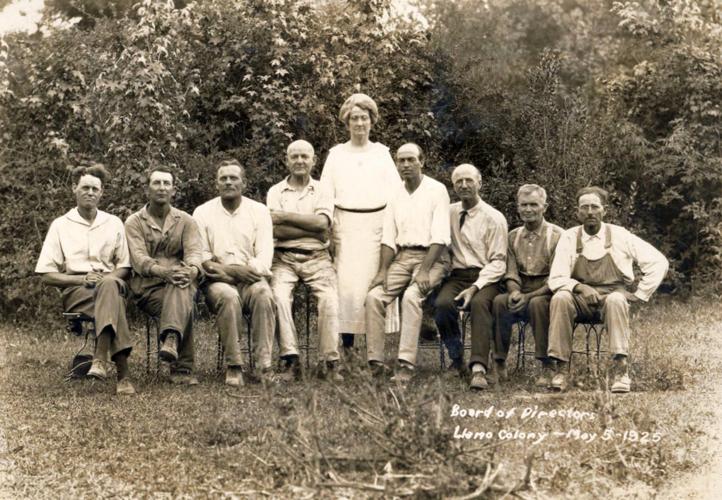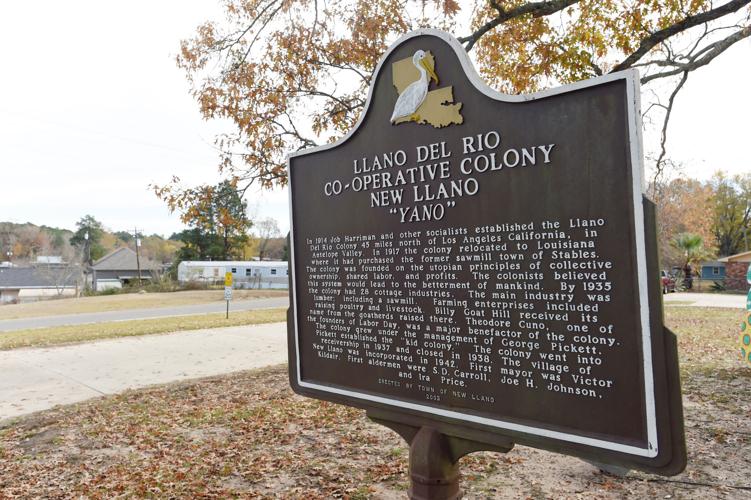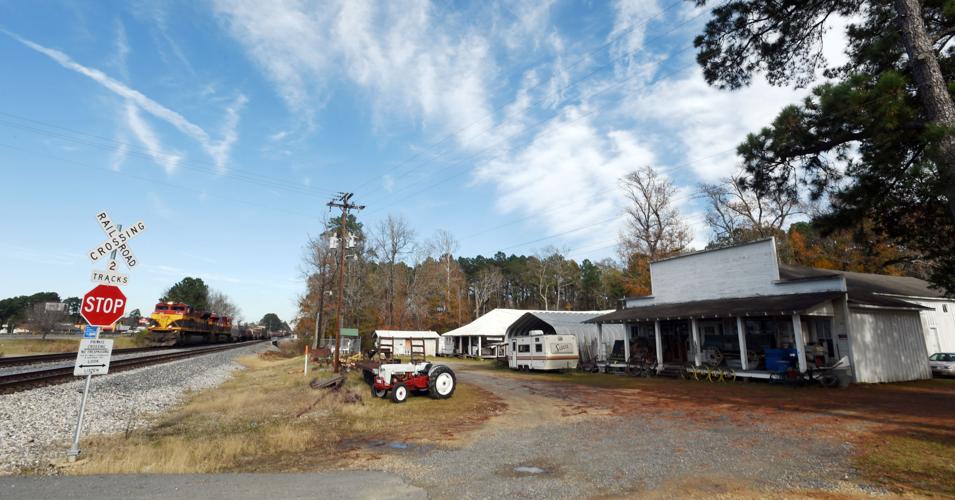
New Llano Colony board of directors, 1925
... It is the only place I know of on the globe where service is rendered for the good of all mankind. Rich or poor ... — C.N. Butts
For C.N. Butts, New Llano was a good idea.
Was he someone important? Well, in the collective colony on Leesville's southern border, everyone was important. That's how the human experiment of utopian communes work, and New Llano's was successful for more than 20 years.
"It was the longest lived utopian community in the United States that was not religiously based," said John Crook, director of the Vernon Parish Tourism Commission.
This is the quick answer to Cynthia Jardon's inquiry about such a community that once operated in Vernon Parish.
"I've heard stories about a utopian community that existed in west Louisiana in the early 20th century," the Alexandria resident said. "It this true? And if it is true, what happened to it?"
To answer that question, the search begins in 1914 in California, when a man named Job Harriman established the Llano del Rio Co-operative Colony outside of Los Angeles. But there were problems.

Job Harriman, undated
"They began having water problems on the property they purchased, because they didn't have water rights to this property," Crook said.
The community began a search to relocate. In 1917, they purchased a Louisiana sawmill town that had been closed by Gulf Lumber. The town was called Stables. It stood a couple of miles south of Leesville.
"The land was available and dirt cheap," Crook said. "And the community chartered a train, loaded up their people and stuff, and came here to the 20,000 acres they had purchased."
That's when Llano Del Rio became New Llano, the name symbolizing a new start in a new place.
Though the Museum of the New Llano Colony has been closed since the COVID-19 pandemic, its website, newllanocolony.com, is fully maintained, stating that Harriman "hoped the success of his colony would demonstrate a better way of living to the world."

An historical marker in front of New Llano City Hall tells the story of the New Llano Colony Wednesday, December 20, 2017, in New Llano, La.
"To spread the word, the colony published two newspapers," the website continues. "One of them, the Llano Colonist, devoted to promoting the 'Llano Way,' had subscribers around the world, many of whom eventually became members, some of them coming to America to join the colony."
"They always used the Spanish pronunciation, 'yah-no,'" Crook said. "ln Spanish, llano means, 'open grassy plain.'"
New Llano actually stood in a terrain known as the highlands, but that didn't matter. The community's purpose and mode of operation was more important to Harriman.
First, all residents purchased a membership, which made them equal owners in the colony. Ownership included all the industries, which they ran themselves; homes, where they provided their own water and electricity — and entertainments.
Yes, it was a socialist society.

The California colony site Llano del Rio, undated
"So, their credo as to morality and ethics was the Golden Rule — do unto others as you would have them do to you," Crook said. "And that was printed in a lot of their materials, but there was no church located in the community."
The colony not only attracted residents from throughout the country but the world.
"It attracted a lot of intelligentsia and Europeans, because Europe had been going through such turmoil with the fall of monarchies and World War I," Crook added. "It also attracted a lot of people who were looking for a better way of life, more equitable for people, and where they weren't under the grind of what was then modern life."

Kindergarten students at New Llano Colony, 1933
The residents established several businesses, including a broom factory and a book bindery. They farmed peanuts from which they produced peanut butter and owned and operated the old town's sawmill, along with a large ice plant.
"They sold ice locally," Crook said. "I think they were kind of the Sonic Ice of their day. They also had a hotel, a school and a lending library, where even people outside the community could borrow books."
The colony also was home to what was known as the "Finest Dance Floor Between Lake Charles and Shreveport"
"They had a social life — and that's how they advertised their entertainment venue," Crook said. "It was called the Roof Garden, and they hosted a lot of big bands that played popular music of the day."

An old New Llano Colony general store, right, and another building, at left, are two of the only remaining structures in New Llano that were built by colonists. They are pictured Wednesday, December 20, 2017.
The "finest dance floor" was an open-air venue located on the roof of the Roof Garden.
"The walls were built about three-quarters high, and there was a huge fireplace on one side of the wooden floor," Crook said. "A lot of local people went to dances there, but that was OK with the residents, because they were an open group about people coming and visiting them and talking to them."
Still, locals living outside of New Llano didn't understand the concept of living in a communal colony, especially the idea of giving up property and paying a fee to join a community.

A general store, center, and other buildings at the New Llano Colony, undated
"They had to pay $2,000 to join or give property of equal worth," Crook said. "The people living outside of New Llano never became violent with the community. They just didn't understand it."
Crook is director of the tourism commission for Vernon Parish and its go-to historian. He, along with fellow historian Martha Palmer, researched New Llano and talked to some of its former residents, many of whom moved to nearby communities after the dissolution of the colony.
"There are hugely interesting individual stories about New Llano," Crook said. "There's one story of a Jewish family in New York who became interested in this way of life. Right before they were to leave for Louisiana, both parents took sick and died. They had three girls, and the oldest daughter put the two youngest ones on a train to come down here. Then, she and a girlfriend hitchhiked down here."

New Llano colonists in a garden, undated
The oldest daughter didn't have enough money for a train ticket, but she was safely reunited with her sisters.
"I actually met the daughter of one of the sisters," Crook said. "She's about 95 now, and she told me the story. Her aunt was the oldest sister who hitchhiked here. Two of the sisters went back to New York. The family had immigrated to the United States from Russia, and the oldest sister went back there. She was killed in one of Stalin's purges."
Meanwhile, back in New Llano, the utopia's shine began tarnishing toward the end of the 1930s. The Great Depression had taken its toll on the colony, which eventually filed for bankruptcy. It was placed into receivership, its assets sold at the receiver’s sale in 1939 and dissolved.

A hand-painted map of the New Llano Colony is on display a the entrance to the Museum of the New Llano Colony Wednesday, December 20, 2017, in New Llano, La.
New Llano's population ebbed and flowed through the years, but the museum's website estimates population averaged 1,000.
"During their time here, they also purchased land in Elton, in Allen Parish, where they had a rice farm," Crook said. "They bought a sugar cane plant, a ranch in New Mexico and land in Mena, Arkansas, where they moved a college that they had founded here."
When New Llano went into receivership, Crook says it was the largest, single dollar amount sale of property in Vernon Parish when it was finally settled, which was in the, either the late '50s or the '60s.
Today, New Llano is an incorporated town governed by a council and mayor.

Children dancing around a maypole at the New Llano Colony, undated
"Though the colony, itself, lasted only a little over two decades, many of the ideals they promoted are taken for granted by Americans today, including minimum wages, equal rights for women and child labor laws, health care and old age pensions," the museum website concludes. "They came from all walks of life and from all over the world seeking Utopia — a paradise where 'you produce for use, not profit,' where all members did equal work for equal benefits.'"










